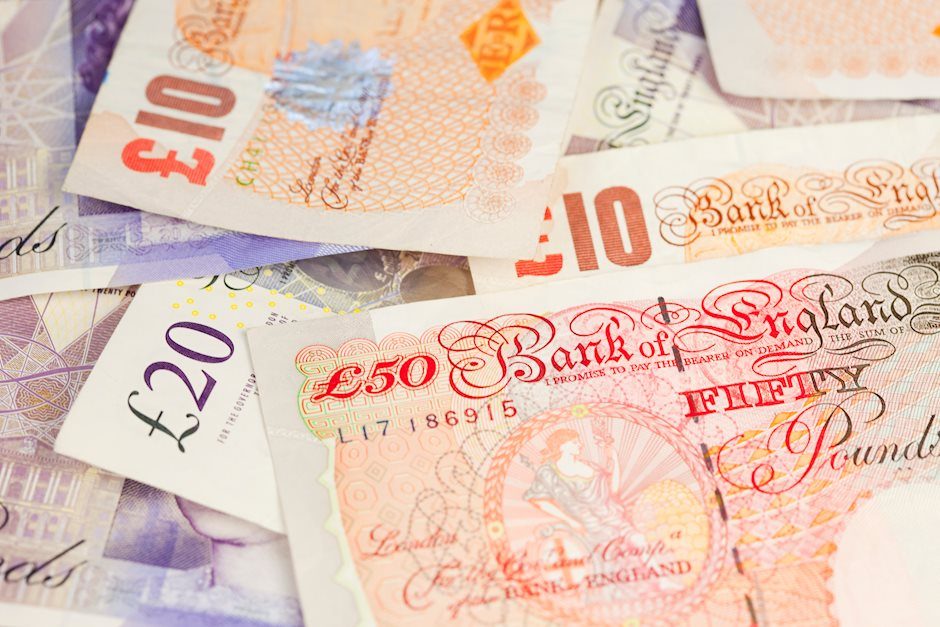GBP/USD Forecast: Pound Sterling stabilizes near key technical level
- GBP/USD struggles to find direction, fluctuates slightly below 1.2800.
- Buyers could take action once Pound Sterling clears 1.2800 resistance.
- Investors will pay close attention to ECB policy decisions, US data.

Following Tuesday's decline, GBP/USD recovered modestly and closed in positive territory on Wednesday. The pair seems to have entered a consolidation phase slightly below 1.2800 and technical buyers could take action in case Pound Sterling manages to clear this level.
British Pound PRICE This week
The table below shows the percentage change of British Pound (GBP) against listed major currencies this week. British Pound was the strongest against the Canadian Dollar.
| USD | EUR | GBP | JPY | CAD | AUD | NZD | CHF | |
|---|---|---|---|---|---|---|---|---|
| USD | -0.26% | -0.33% | -0.73% | 0.45% | 0.10% | -0.76% | -1.28% | |
| EUR | 0.26% | -0.04% | -0.48% | 0.72% | 0.24% | -0.50% | -1.04% | |
| GBP | 0.33% | 0.04% | -0.36% | 0.75% | 0.35% | -0.52% | -1.00% | |
| JPY | 0.73% | 0.48% | 0.36% | 1.15% | 0.89% | 0.11% | -0.39% | |
| CAD | -0.45% | -0.72% | -0.75% | -1.15% | -0.37% | -1.21% | -1.74% | |
| AUD | -0.10% | -0.24% | -0.35% | -0.89% | 0.37% | -0.74% | -1.30% | |
| NZD | 0.76% | 0.50% | 0.52% | -0.11% | 1.21% | 0.74% | -0.58% | |
| CHF | 1.28% | 1.04% | 1.00% | 0.39% | 1.74% | 1.30% | 0.58% |
The heat map shows percentage changes of major currencies against each other. The base currency is picked from the left column, while the quote currency is picked from the top row. For example, if you pick the British Pound from the left column and move along the horizontal line to the US Dollar, the percentage change displayed in the box will represent GBP (base)/USD (quote).
The US Dollar (USD) benefited from the upbeat ISM Services PMI data on Wednesday and made it difficult for GBP/USD to gather bullish momentum. Nevertheless, the pair held its ground as risk flows dominated the action during the American trading hours.
US stock index futures trade virtually unchanged in the European session on Thursday, reflecting a neutral risk mood.
Later in the day, the US Department of Labor will release the weekly Initial Jobless Claims data. A noticeable increase in the number of first-time applications for unemployment benefits could weigh on the USD. Ahead of Friday's highly-anticipated May jobs report, however, the market reaction to Jobless Claims data could remain short-lived.
Investors will also pay close attention to the European Central Bank's (ECB) policy announcements. The ECB is forecast to lower key rates by 25 basis points. In case the ECB adopts a dovish tone, EUR/GBP could decline sharply and help GBP/USD limit its losses, even if the USD gathers strength in the second half of the day.
GBP/USD Technical Analysis
GBP/USD faces immediate resistance at 1.2800, where the mid-point of the ascending regression channel is located. Once the pair rises above this level and starts using it as support, it could target 1.2850 (static level) and 1.2900 (upper limit of the ascending channel) next.
On the downside, the 50-period Simple Moving Average (SMA) aligns as first support at 1.2760 before 1.2730 (lower limit of the ascending channel, 100-period SMA) and 1.2700 (psychological level, static level).
Pound Sterling FAQs
The Pound Sterling (GBP) is the oldest currency in the world (886 AD) and the official currency of the United Kingdom. It is the fourth most traded unit for foreign exchange (FX) in the world, accounting for 12% of all transactions, averaging $630 billion a day, according to 2022 data. Its key trading pairs are GBP/USD, aka ‘Cable’, which accounts for 11% of FX, GBP/JPY, or the ‘Dragon’ as it is known by traders (3%), and EUR/GBP (2%). The Pound Sterling is issued by the Bank of England (BoE).
The single most important factor influencing the value of the Pound Sterling is monetary policy decided by the Bank of England. The BoE bases its decisions on whether it has achieved its primary goal of “price stability” – a steady inflation rate of around 2%. Its primary tool for achieving this is the adjustment of interest rates. When inflation is too high, the BoE will try to rein it in by raising interest rates, making it more expensive for people and businesses to access credit. This is generally positive for GBP, as higher interest rates make the UK a more attractive place for global investors to park their money. When inflation falls too low it is a sign economic growth is slowing. In this scenario, the BoE will consider lowering interest rates to cheapen credit so businesses will borrow more to invest in growth-generating projects.
Data releases gauge the health of the economy and can impact the value of the Pound Sterling. Indicators such as GDP, Manufacturing and Services PMIs, and employment can all influence the direction of the GBP. A strong economy is good for Sterling. Not only does it attract more foreign investment but it may encourage the BoE to put up interest rates, which will directly strengthen GBP. Otherwise, if economic data is weak, the Pound Sterling is likely to fall.
Another significant data release for the Pound Sterling is the Trade Balance. This indicator measures the difference between what a country earns from its exports and what it spends on imports over a given period. If a country produces highly sought-after exports, its currency will benefit purely from the extra demand created from foreign buyers seeking to purchase these goods. Therefore, a positive net Trade Balance strengthens a currency and vice versa for a negative balance.
Premium
You have reached your limit of 3 free articles for this month.
Start your subscription and get access to all our original articles.
Author

Eren Sengezer
FXStreet
As an economist at heart, Eren Sengezer specializes in the assessment of the short-term and long-term impacts of macroeconomic data, central bank policies and political developments on financial assets.


















